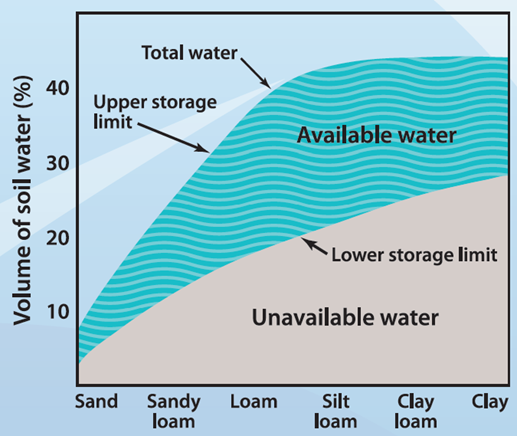We've collected the answers to some of the questions we've most commonly been asked about the Farming Forecaster platform. Our Training Resources page also has some fantastic resources for learning more about how the different parts of the Farming Forecaster platform work.
If you have any questions about the platform or its content, please contact us - we're always up for a chat and would appreciate your feedback.
The following three pieces of data is collected from all sites on Farming Forecaster that feature a capacitance probe:
- Soil moisture
- Soil temperature
- Rainfall
Soil moisture and soil temperature is measured via a vertical capacitance probe, with measurements taken at various depths in the soil. It is important to note that the depth and frequency of measurements taken can differ slightly between sites depending on the brand of capacitance probe and depth of installation (e.g. some probes have been installed 10cm below the soil surface to prevent damage by machinery during a cropping phase).
Rainfall is automatically measured at each probe site using a tipping bucket rain gauge. In addition to the tipping bucket, some sites also feature a weather station, enabling extra information such as temperature, wind speed/direction, humidity and Delta- T to be recorded and displayed on Farming Forecaster.
Under the 'Probe' sub heading on Farming Forecaster, there will be some text that indicates when the information was last sent from the field and uploaded onto Farming Forecaster. For example, “Last update:1 hour ago” or “Last update: Wednesday 7:00 AM”. The information displayed should be current (i.e. within the last 3 - 4 hours), however sometimes there can be a delay if the modem in the paddock is struggling to pick up signal due to bad weather, or if the site is experiencing technical issues (e.g. flat battery, lose wiring etc.).
No. The fenced off area has been erected to protect the rain bucket and electrical equipment that logs and transmits the data from being damaged by livestock. Importantly, the capacitance probe is located 5 to 10 metres away from the fenced area, enabling us to monitor soil moisture conditions under grazed pastures.
Capacitance probes measure soil moisture content by measuring the capacitance between two electrodes. The higher the moisture content of the soil, the higher the electrical conductivity reading.
Capacitance probes start taking measurements immediately once they are installed. To calibrate the probes and make sense of the probe readings, we need to collect sufficient data over time to establish the upper (wet) and lower (dry) limits for each sensor depth. Once these levels have been established, we can then express the current reading as a relative reading in the established range. This reading is then converted to a moisture percentage on the Farming Forecaster website. If the number displayed is 100%, this means that the soil at that particular depth is fully wetted up – in soil terminology this point is referred to as field capacity. At the other end of the scale, if the number displayed shows say 10 to15% plant available water, this is indicating that the soil is becoming extremely dry. Plants will stop growing before the moisture readings reach zero %.
The colour coding that is applied to the moisture percentage numbers on Farming Forecaster is based on a traffic light system:
- Green = reading is 75% or above (wet)
- Orange = reading is sitting somewhere between 25-75%
- Red = reading has fallen below 25% and is very dry
The soil moisture readings are site and soil specific and indicate the amount of soil water available to the plant. Different soils depending on their texture, structure and organic matter content have different capacity to hold and release water. Soil texture is the main driving factor. Clay soils have greater water holding capacity than sandy soils which tend to drain more freely (Figure 1). For example, a clay soil showing 100% soil moisture will have a lot more stored soil moisture and water available for plant growth compared to a sandy loam soil also showing 100% soil moisture.
Once you have identified soil moisture probes on Farming Forecaster that you might use as a reference point, it is important to review the soil information on the website (for the relevant probes) and think about how the soil compares to the soil types on your farm.

Plants have a wide range of soil water levels where they can function at top performance and growth is uninhibited. However, as a soil dries out a point is reached where water uptake by the plant (via the roots) can not keep pace with evaporation from the leaves. When this occurs, plants become water stressed and pasture growth is reduced. This can be visually evident through leaf flaccidity, folding or drooping. It is important to note that water stress will occur before the moisture percent figures on Farming Forecaster reach zero.
Even if you don’t have a soil moisture sensor near your property, valuable information can be gained from Farming Forecaster. This can be done by looking at several moisture probes in your region and looking for trends or local patterns. For example, 5 or 6 moisture probes closest to you could be all showing very good soil moisture down to 30-40cm, but very dry conditions below 40cm. Or perhaps the network is indicating a very strong east-to-west (or a north-to-south) trend in soil moisture due to rainfall patterns in recent months. Looking at several moisture probes provides much more powerful information than just focusing on a single site.
Pasture growth rate is influenced by several factors including leaf area, soil fertility (nutrient availability), water availability and temperature.
Soil and air temperature both play a role in plant growth and development. Soil temperature impacts the rate of below ground processes – a warmer soil results in more rapid decomposition of organic matter, increased microbiological activity and quicker release of nutrients. Above the ground, as air temperature increases (up to a point), photosynthesis, transpiration and respiration rate increase. All species have a temperature range in which they will grow. For example, for temperate (winter growing) legume and grass species the minimum temperatures for growth are 5 and 8 degrees respectively with a maximum of 27 to 30 degrees. Growth will be slower when the temperatures are near either end of the range.
Soil and air temperature is highly correlated – an increase in air temperature leads to an increase in soil temperature (and vice versa).
Soil temperature at the various sensor depths is measured by the capacitance probes displayed on Farming Forecaster. 9 am soil temperature at 10cm is the common reference point and can be useful indicator for.
- predicting pasture growth rates: research indicates that for temperate pasture species, pasture growth ceases when soil temperature at 10cm falls below 5◦C.
- when to apply nitrogen (N) applications: even though growth responses can occur down to a soil temperature of 5◦C, to achieve a more efficient response the rule of thumb is to aim for a soil temperature of 8 ◦C to 10◦C (soil temperature reading at 10cm at 9am).
- when to apply gibberellic acid (GA) application: GA is a naturally occurring plant hormone that is sometimes applied in winter to boost pasture growth. As a general rule of thumb, GA should be applied when pastures have at least 800kg/ha (green herbage), air temperature is between 5-15°C and soil temperature is above 5°C.
- when to sow a pasture or crop: most seeds require temperatures within certain ranges to germinate. Although grasses and cereals will often germinate and grow reliably below about 8-10°C, most temperate species are best sown at soil temperatures of between 12-20°C. The ideal soil temperature for establishing lucerne is 12°C and rising. Tropical pasture species can be sown once the soil temperature reaches 16 °C and rising at 9am (the same as sorghum).
Refer to below webinars for further information:
Brr it's cold in here: The effects of temperature on pasture production (MLA webinar)
Using soil moisture and temperature data for optimising growth (Agriculture Victoria webinar)
Rainfall is recorded at all moisture probe sites using an automatic rain gauge (tipping bucket). Having access to rainfall data enables users to better interpret soil moisture readings and apply the information back to their own farm.
Some sites have a pasture forecast, but don’t feature a soil moisture probe or rain gauge. These sites are referred to as ‘virtual’ sites. Virtual sites also display rainfall and soil moisture information, however this information is synthetic/ modelled data. For example, the rainfall data displayed is based on Gridded Data which is what Farming Forecaster used to produce the pasture forecast for that location (using GrassGro). Soil moisture data for virtual sites is produced by GrassGro and is displayed as plant available soil moisture (mm) via a box plot.
Rainfall is automatically measured at each probe site using a tipping bucket rain gauge. In addition to the tipping bucket, some sites also feature a weather station, enabling extra information such as temperature, wind speed/direction, humidity and Delta- T to be recorded and displayed on Farming Forecaster.
 and then Add to Home Screen.
and then Add to Home Screen.